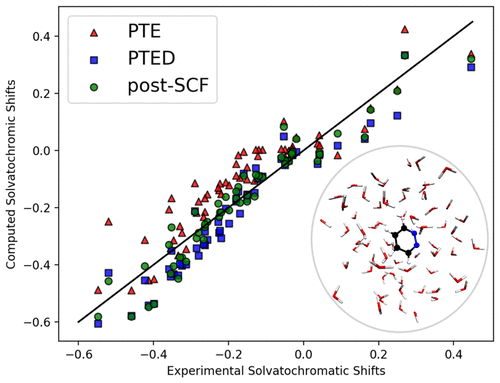当前位置:
X-MOL 学术
›
J. Chem. Theory Comput.
›
论文详情
Our official English website, www.x-mol.net, welcomes your
feedback! (Note: you will need to create a separate account there.)
Comparison of Reaction Field Schemes for Coupling Continuum Solvation Models with Wave Function Methods for Excitation Energies.
Journal of Chemical Theory and Computation ( IF 5.7 ) Pub Date : 2020-05-29 , DOI: 10.1021/acs.jctc.0c00316 Sarah Karbalaei Khani 1 , Alireza Marefat Khah 1 , Christof Hättig 1
Journal of Chemical Theory and Computation ( IF 5.7 ) Pub Date : 2020-05-29 , DOI: 10.1021/acs.jctc.0c00316 Sarah Karbalaei Khani 1 , Alireza Marefat Khah 1 , Christof Hättig 1
Affiliation

|
We address in this work the question to which extend reaction field schemes for correlated wave function methods give accurate excitation energies and, at the same time, physically consistent potential energy surfaces. The performance of the perturbation on energy (PTE), perturbation on energy and density (PTED), and post-SCF reaction field schemes is compared for the algebraic diagrammatic construction through second-order, ADC(2), as electronic structure and the conductor-like screening model COSMO as solvation model. The conditions on reaction field schemes to give physically consistent potential energies surfaces are discussed at the example of 4-(N,N-dimethylamino)benzonitrile, which is used as a test case to assess the artifacts introduced by state-specific contributions to the effective Hamiltonian. To evaluate the accuracy for excitation energies, we use two benchmark sets with data in gas phase and solution for ππ* and nπ* electronic transitions. The experimental solvatochromic shifts are compared to the corresponding calculated values at the COSMO-ADC(2) level with the PTE scheme within the frozen solvent approximation, PTED with the linear response (LR) and corrected linear response (cLR) and post-SCF with LR schemes and with the approximate coupled-cluster singles and doubles method CC2 combined with COSMO in the post-SCF (LR) scheme. The PTE scheme gives at the COSMO-ADC(2) level less accurate solvent shifts than the PTED(LR), PTED(cLR), and post-SCF(LR) schemes. The most accurate prediction of solvatochromism is obtained with the post-SCF(LR) scheme. In most cases, PTED(cLR) performs similar to post-SCF, although its nonlinear perturbative correction causes problems for potential energy surfaces.
中文翻译:

激励能量耦合波解法与连续函数耦合模型反应场方案的比较。
我们在这项工作中解决了以下问题:相关波函数方法的反应场方案可以扩展给出准确的激发能,同时还可以提供物理上一致的势能面。通过二阶ADC(2)作为电子结构和导体,比较了能量扰动(PTE),能量扰动和密度(PTED)和后SCF反应场方案的性能,以进行代数图解构造。类筛选模型COSMO作为溶剂化模型。给出物理上一致的势能表面的反应场方案的条件在4-(N,N-二甲基氨基)苄腈,用作评估特定国家对有效哈密顿量的贡献所引入的伪影的测试用例。为了评估激发能的准确性,我们使用了两个基准集合,其中包含气相数据和ππ *和nπ解的数据*电子转换。实验溶剂光致变色与COSMO-ADC(2)级别上的相应计算值进行比较,其中采用PTE方案在冷冻溶剂近似值下进行,PTED进行线性响应(LR),校正后的线性响应(cLR),SCF后采用LR方案以及在后SCF(LR)方案中结合COSMO的近似耦合集群单双打方法CC2。与PTED(LR),PTED(cLR)和post-SCF(LR)方案相比,PTE方案在COSMO-ADC(2)级别上提供的准确的溶剂移位较少。使用后SCF(LR)方案可获得最准确的溶剂化变色预测。在大多数情况下,尽管PTED(cLR)的非线性微扰校正会引起势能面问题,但其性能与SCF后类似。
更新日期:2020-07-14
中文翻译:

激励能量耦合波解法与连续函数耦合模型反应场方案的比较。
我们在这项工作中解决了以下问题:相关波函数方法的反应场方案可以扩展给出准确的激发能,同时还可以提供物理上一致的势能面。通过二阶ADC(2)作为电子结构和导体,比较了能量扰动(PTE),能量扰动和密度(PTED)和后SCF反应场方案的性能,以进行代数图解构造。类筛选模型COSMO作为溶剂化模型。给出物理上一致的势能表面的反应场方案的条件在4-(N,N-二甲基氨基)苄腈,用作评估特定国家对有效哈密顿量的贡献所引入的伪影的测试用例。为了评估激发能的准确性,我们使用了两个基准集合,其中包含气相数据和ππ *和nπ解的数据*电子转换。实验溶剂光致变色与COSMO-ADC(2)级别上的相应计算值进行比较,其中采用PTE方案在冷冻溶剂近似值下进行,PTED进行线性响应(LR),校正后的线性响应(cLR),SCF后采用LR方案以及在后SCF(LR)方案中结合COSMO的近似耦合集群单双打方法CC2。与PTED(LR),PTED(cLR)和post-SCF(LR)方案相比,PTE方案在COSMO-ADC(2)级别上提供的准确的溶剂移位较少。使用后SCF(LR)方案可获得最准确的溶剂化变色预测。在大多数情况下,尽管PTED(cLR)的非线性微扰校正会引起势能面问题,但其性能与SCF后类似。











































 京公网安备 11010802027423号
京公网安备 11010802027423号